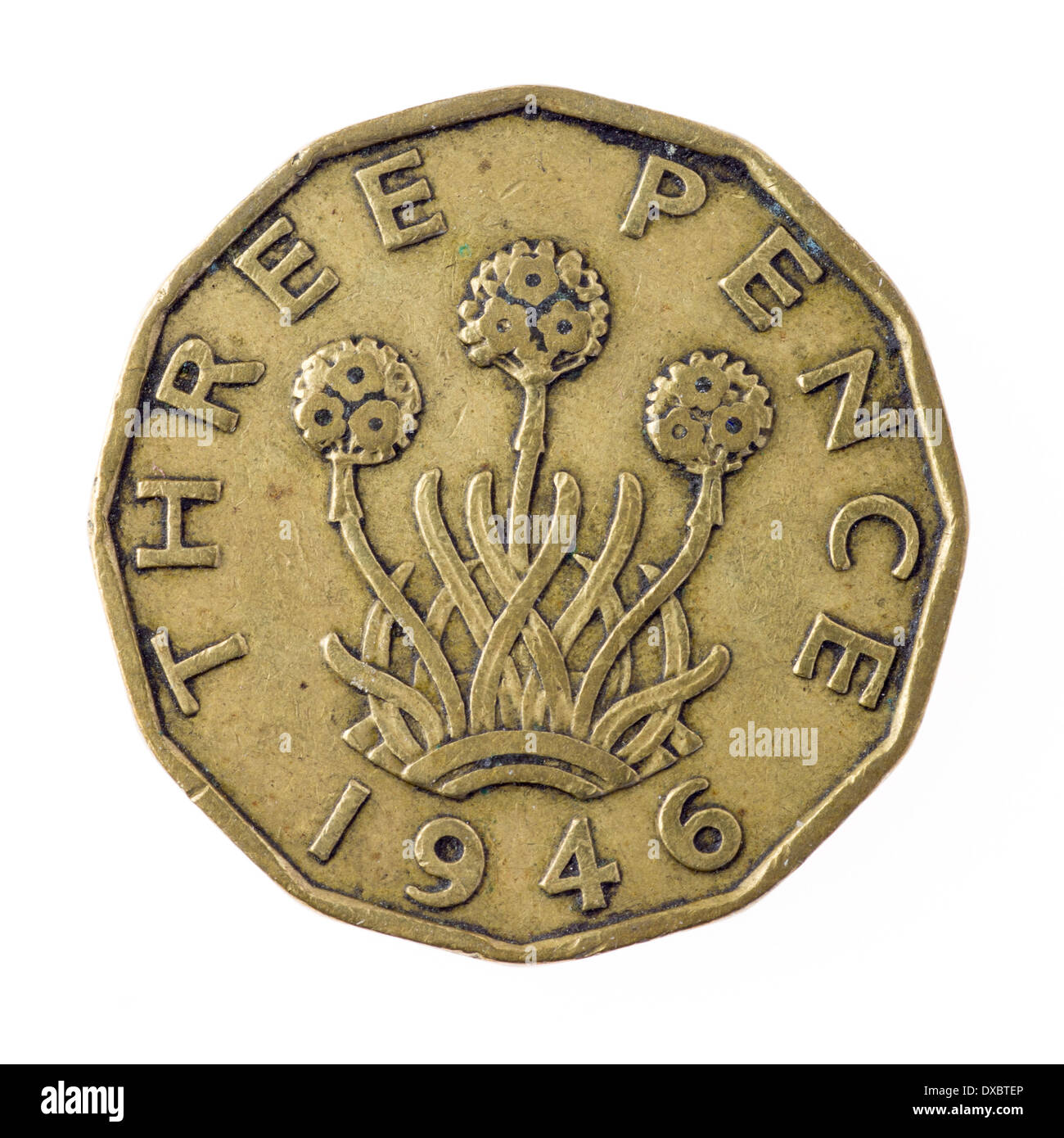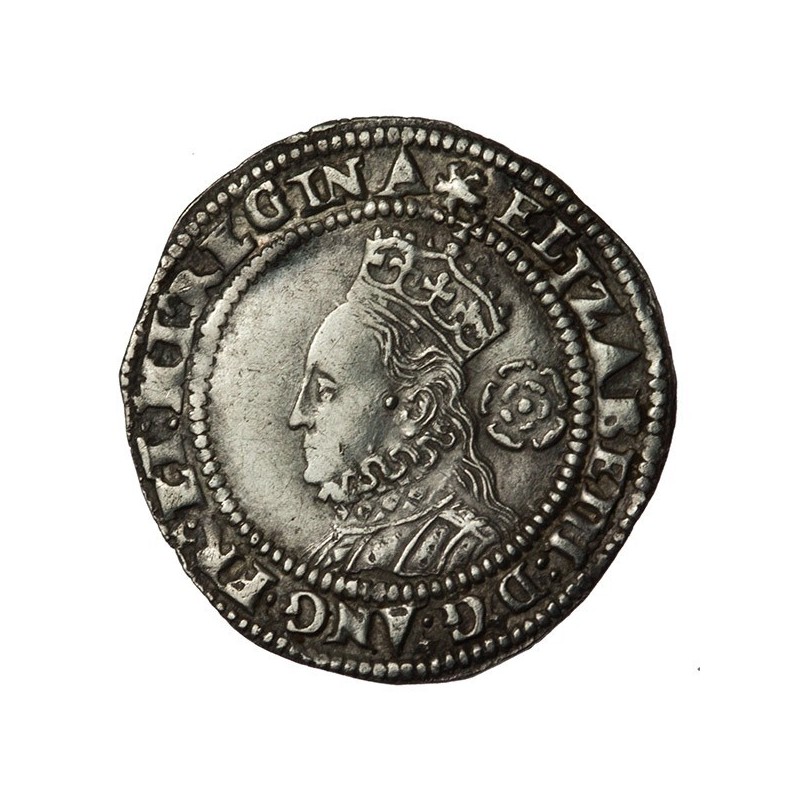Threepence
| Value | 3 pence |
|---|---|
| Mass | 3.23 g |
| Diameter | 17.7 mm |
| Thickness | 1.9 mm |
| Edge | Plain |
| Composition | Nickel (1928–1942) Cupronickel (1942–1969) |
| Years of minting | 1928–1969 |
| Catalog number | — |
| Obverse | |
| Design | Irish harp |
| Design date | 1928 |
| Reverse | |
| Design | Irish hare |
| Designer | Percy Metcalfe |
| Design date | 1928 |
The threepence (Irish: leath reul[l̠ʲah ɾˠeːlˠ]) or 3dcoin was a subdivision of the pre-decimalIrish pound, worth 1⁄80 of a pound or 1⁄4 of a shilling. Leath reul literally means 'half reul', the reul being a sixpence coin worth about the same as the Spanish real (a quarter of a peseta). As with all other Irish coins, it resembled its British counterpart, as the Irish pound was pegged to the British pound until 1979.
- Noun (used with a singular or plural verb)British. A sum of three pennies. A former cupronickel coin of the United Kingdom, a quarter of a shilling, equal to three pennies: use phased out after decimalization in 1971.
- The farmer was a sad miser, and knew that his man was very simple-hearted; so he took out threepence, and gave him for every year's service a penny.
- Threepence Junior members, admitted in 1907, paid threepence or sixpence, depending on age. From the Cambridge English Corpus At one penny admission they were cheaper than the threepence needed for.
The obligation to pay threepence a week towards her maid's ' stamp ' was, she said, tyranny. Times, Sunday Times (2009) With the princely sum of threepence at stake, no lemonade bottle ever found its way into our dustbin. Times, Sunday Times (2006). The threepence (Irish: leath reul l̠ʲah ɾˠeːlˠ) or 3d coin was a subdivision of the pre-decimal Irish pound, worth 1 ⁄ 80 of a pound or 1 ⁄ 4 of a shilling. Leath reul literally means 'half reul', the reul being a sixpence coin worth about the same as the Spanish real (a quarter of a peseta).

Originally it was struck in nickel and was very hard-wearing. In 1942, as nickel became more costly, the metal was changed to cupronickel of 75% copper and 25% nickel. The coin measured 17.6 millimetres (0.69 in) in diameter and weighed 3.2400 grams (0.11429 oz);[1] this did not change with the cupro-nickel coin.[2] The coin was minted at the Royal Mint starting from 1928, and ceased to be legal tender after decimalisation on 31 December 1971. Ireland did not adopt the brass dodecagonal threepenny coin that the United Kingdom used between 1937 and 1971.
The reverse design featuring an Irish hare was by English artist Percy Metcalfe. The obverse featured the Irish harp. From 1928 to 1937 the date was split either side of the harp with the name Saorstát Éireann circling around. From 1938 to 1969 the inscription changed to Éire on the left of the harp and the date on the right.[3]
See also[edit]
References[edit]
- ^Numismatic Guaranty Corporation: 1928-1935 Irish threepence
- ^Numismatic Guaranty Corporation: 1942-1968 Irish threepence
- ^'Coin types from Ireland'. World Coin Gallery. Retrieved 9 November 2011.

External links[edit]
The second known example of the “rarest British circulating coin in 200 years” is now certified as genuine by Numismatic Guaranty Corporation.
The tiny silver coin was found in an ordinary Whitman folder, the type of cardboard booklet that young coin enthusiasts have filled with coin collections since the 1930s.
Threepence 1891
After being removed from the Whitman folder, the coin was placed in a plastic envelope, or flip, and brought to Baldwin’s of St. James’s, managing director Stephen Fenton said.
Humble source of rarity
The coin caused an immediate sensation at the firm.
Threepence Meaning
“It was a coin I’d looked for for 50 years,” Fenton said. “I regard this as the rarest British circulating coin for 200 years.
“You see lots of rare coins, but this is something I’ve always hoped to see someday. It’s amazing proof that the rarest coins can emerge from the most humble of places.”
Though the Nazis showered London with V-2 rockets in 1945, it was a more mundane reason that led to the extreme rarity of the 1945 silver threepence.
The silver threepence had become unpopular because it was very small — a diameter of 16 millimeters (six-tenths of an inch) and a weight of 1.4 grams.
A bigger, heavier, 12-sided nickel-brass threepence had been introduced in 1937 and was being minted every year.
The King George VI silver threepence was minted from 1937 to 1945, with a peak production of almost 8 million coins annually in 1940 and in 1941. But the wartime issues of 1942 to 1945 were all shipped to the British West Indies.
The output of 1945, the coin’s final year, a mintage of 371,000 pieces, was apparently deemed redundant because of public acceptance of the nickel-brass version and was ordered to be melted down, its silver to be used in other mint products.

Most were melted
Every 1945 silver threepence was supposed to have been reduced to ingots, their inscriptions and profile of the king on the obverse and a St. George’s cross over a Tudor rose on the reverse destroyed.
But at least two coins escaped the crucible, and more of them might be sitting in jars or Whitman folders, waiting to be recognized for the rarities they are.
One survivor came up for auction in April 1970 at a Glendining & Co. of London sale.
Its condition was described in the catalog as About Very Fine, and it realized £260 (about £4,000, or $5,283 U.S. in today’s money). Its buyer is unknown, and the coin has not resurfaced publicly since.
According to NGC, that first-known example is thought to grade Very Fine 20 to VF-35.
The newly found coin was certified by NGC and graded Mint State 63.
“I had no doubt that this coin was genuine,” Fenton said. “But NGC certification will ensure that everyone has the same confidence.”
The new example is being offered at a Baldwin’s of St. James’s auction scheduled for March 2020, with an estimate of £15,000 to £25,000 ($19,812 to $33,019 U.S.), Fenton said.
How did it survive?
The owners, who Fenton declines to name, said they received the Whitman folder containing the coin from a relative who worked at the Royal Mint.
Threepence Definition
Though Whitman no longer makes folders for British coins, older examples (often with coins intact) can still be found.
Connect with Coin World:

Sign up for our free eNewsletter
Access our Dealer Directory
Like us on Facebook
Follow us on Twitter